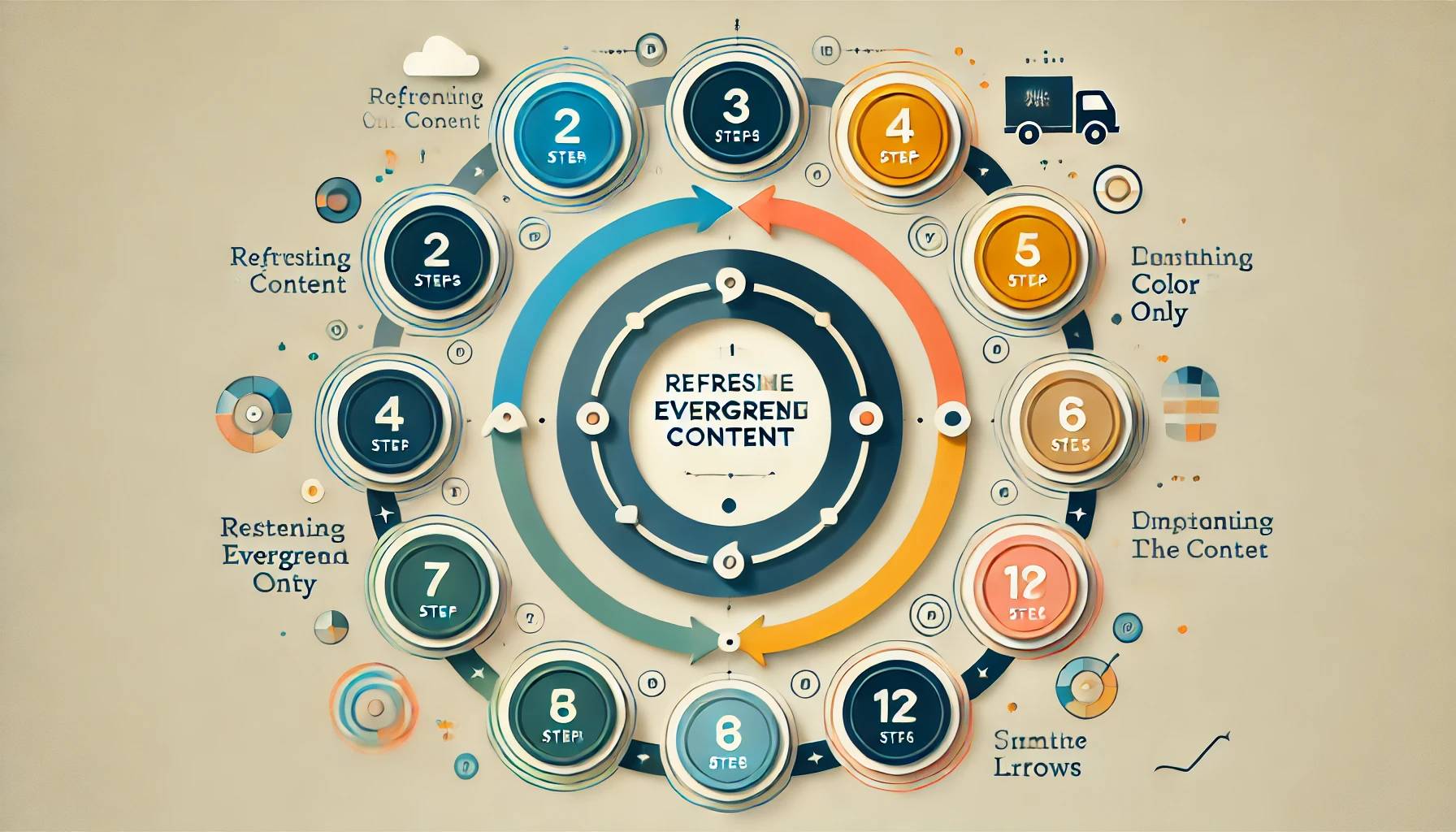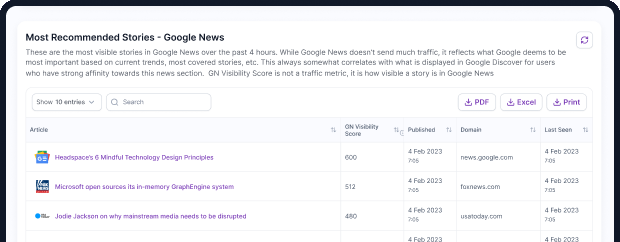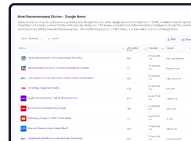Refreshing Evergreen Content: A Comprehensive Guide

In the fast-paced world of digital content, staying relevant is crucial for maintaining and growing your audience, especially for news publishers. One powerful strategy to achieve this is by refreshing evergreen content. With the fast-paced nature of news cycles, content can quickly become outdated, leading to a significant drop in search traffic. However, evergreen content offers a solution to this problem, providing sustained traffic and relevance long after its initial publication.
This article explores the concept of evergreen content, its importance, and how to effectively refresh it to maximize its impact.
Scroll all the way down for the slides.
What is Evergreen Content?
The definition of evergreen content can indeed differ not only across news organizations but also within different teams at the same place. While some analysts might classify evergreen content based purely on a timeframe (e.g., anything published within the past 'x' days/weeks), I prefer a more dynamic approach. I define evergreen content based on its enduring relevance and its capacity to generate consistent traffic, irrespective of its publication date.
Naturally, there are some nuances to this definition. We have evergreen seasonal content (think "best winter coats") and evergreen news content (like "how to find your voting location").
Unlike news articles that peak in traffic shortly after publication and then rapidly decline, evergreen content has everlasting interest and continues to attract visitors for months or even years. Examples include:
- How-to guides
- Comprehensive tutorials
- In-depth explanations of fundamental concepts
- Lists of timeless resources or ideas
- Historical overviews, History of a topic/product
- Answering Questions (why, when, what, how, where, who)
- Checklist, Tips
- Best, Top, Worst, etc
- Complete Glossary
- Everything you need to know (Guide) about a topic
- Tutorial
Confused? Ask yourself:
“Can I re-post this content on Facebook/social media 3 - 6 months from now?”
If yes, then it is evergreen content!
What Evergreen Content is Not:
- News articles
- Statistics or numerical reports that are likely to change and go out of date
- Pieces about a specific holiday or season
- Articles focused on a current trend or pop culture fad
- Latest clothing and fashion trends
I firmly believe every newsroom requires a balance of news/trendy and evergreen content – perhaps a 70/30 split, in either direction. That's why at NewzDash.com (our real-time news SEO software), we offer both news and evergreen content research tools, and at GDDash, we help identify evergreen content that might need a refresh to regain traction. Keeping track of all published evergreen pieces and knowing when to update them is one of the biggest challenges for news SEOs today.
The power of evergreen content lies in its ability to continually attract traffic, engage readers, and provide value over an extended period.
Evergreen vs. News: The Traffic Dichotomy
In the digital publishing realm, content is king. However, not all content holds the same value over time. Publishers should focus on two primary content types: evergreen and news. Each serves distinct purposes and requires a different approach for optimization.
| Evergreen Content | News Content |
|---|---|
|
|
|
Examples
|
Examples:
|
Why Refresh Evergreen Content?
While evergreen content is designed to have a long shelf life, it's not immune to the passage of time. Regularly refreshing this content is crucial for maintaining its relevance, effectiveness, and value. Here are several compelling reasons why content refreshing should be a key part of your digital strategy:
- Combating Content Decay: Over time, even the most well-crafted evergreen content can become outdated or less relevant. Regular updates ensure your content remains accurate and useful to your audience.
- Adapting to Search Algorithm Changes: Search engines frequently update their algorithms, which can significantly impact how content is ranked. Refreshing your content allows you to align with these changes and maintain or improve your search visibility.
- Staying Competitive: As new content on similar topics emerges, your once-authoritative piece may lose ground. Refreshing helps you stay ahead of the competition and maintain your position as a go-to resource.
- Meeting User Expectations: Readers, especially in rapidly evolving fields, expect up-to-date information. Regular content refreshes demonstrate your commitment to providing current, valuable insights.
- Maximizing SEO Benefits: Refreshing content can significantly improve search rankings and drive more traffic. Moreover, concentrating your efforts on updating and consolidating existing content is often more effective than creating numerous new pieces on the same topic, which can dilute traffic and link equity.
- Enhancing Cost Efficiency: Updating and expanding existing content is typically more cost-effective than constantly producing new articles on similar topics. This approach is particularly beneficial for publishers with extensive archives covering the same subjects repeatedly.
- Reducing Content Bloat: Many publishers fall into the trap of continually creating new content on the same topics, leading to an accumulation of redundant, low-performing articles. A study by ahrefs revealed that 91% of content published online receives no traffic from Google. This issue is likely to worsen with the increasing flood of AI-generated and spam content. By focusing on refreshing and consolidating your best pieces, you can maintain a leaner, more effective content library.
- Improving Overall Site Quality: By regularly updating your top-performing evergreen content, you elevate the overall quality of your site. This not only benefits your audience but can also positively impact your domain authority and search engine rankings. Another element to consider is Helpful Content Updates that may impact negatively low quality content.
- Leveraging Existing Authority: Older content that has already accumulated backlinks and social shares has a head start in terms of authority. Refreshing this content allows you to capitalize on its existing strength while improving its relevance and value.

The Pinetree Project: A Case Study in Content Refreshing
The Pinetree Project was launched in 2016 as an SEO initiative aimed at updating and consolidating existing content across multiple brands. The goal was to refresh evergreen content, merge similar articles, and optimize them for better search performance. This project was rooted in the understanding that creating new content is not always the answer; instead, enhancing the value of existing content can yield significant results
The project demonstrated impressive results:
- Involved 6 brands and over 400 stories
- Achieved a 275% increase in search traffic
- Significantly increased the number of ranked keywords

Content Merges: A Key Aspect of Content Refreshes
An important aspect of Content Refreshes is Content Merge where we find similar content with the same focus that is not performing and consolidate into one article.
Consolidating multiple similar articles into a single comprehensive well-optimized evergreen article which delivers better authority and traffic than keeping them separate.
Imagine 5 articles that discuss the same topic (A), each article will get a piece of the authority and few links, if we consolidate all these articles into one and optimize/enhance the content and continue to refresh it periodically, that content will have much better authority and traffic than the combined 5 articles

Establish a Quota
In my experience each publisher should establish certain quotas for 1) New News Content 2) New Evergreen Content 3) Refreshed existing evergreen content.
Assign content refreshes to experienced editorial SEO team members; refreshing evergreen content takes experienced SEO writers.
3 Ways to Identify Evergreen Content
- identify high potential evergreen pages: either by manually collecting a list of pages or using tools (GDdash.com can identify all evergreen pages that lost traffic below X% and are good potential to refresh)
- Identify high search volume keywords within a targeted topic cluster
- Identify high search volume keywords within different topics based on specific characteristics (for example optimize all "BEST" keywords for your site)

11 Steps to Effectively Refresh Evergreen Content

- Identify Evergreen Content (or Keywords) to Refresh:
- Select pages for refreshing based on specific topics and organizational goals (traffic, subscriptions, etc.).
- Look for "striking distance" URLs (ranking in positions 5-20 for high-volume keywords)
- Consider seasonality and ongoing relevance.
- Analyze Selected Pages:
- Evaluate traffic, keywords, rankings and permissions to change content.
- Evaluate accuracy, and relevancy.
- Identify primary keywords for these pages and ensure targeted keywords remain high-volume and relevant.
- Identify the topic clusters these pages belong to and create a cluster map
- Identify gaps in content or areas for improvement
- Consider Content Consolidation:
- Identify similar, low-performing content on-site and explore merging possibilities (respecting copyright, legal, authorship, etc.).
- Consolidate 5-10 similar weak articles on the same topic into one authoritative piece
- Use 301 redirects to point old URLs to the updated content.
- Analyze Google SERPs:
- Evaluate the search engine results page (SERP) for target keywords
- Check SERPs, features, and content formats to confirm your approach aligns with current user intent.
- Look for opportunities to capture featured snippets and/or AI Overviews
- Analyze Ranking Pages in SERPs:
- Study top-ranking sites/pages to understand their success
- Identify how recent is the ranking content (via publish dates)
- Identify content formats (long form articles, galleries, listicles, etc.)
- Analyze Content Characteristics:
- Identify Article content outline (headings)
- Identify essential terms, and entities
- Identify most frequent questions,
- Identify content length, visuals, user-generated content, internal links, etc. for your topic.
- Identify Content Gaps in your content.
- information gain: Your refreshed content must surpass what's currently ranking.
- Update Content (Merge & Expand):
- Update content based on previous analysis; Incorporate relevant keywords naturally throughout the content
- Update article formats, add or update visuals (images, infographics, videos)
- Build a semantic article outline (1 H1, multiple H2s to lead the user into multiple sections of the article)
- Merge low-performing content (if applicable)
- Expand new content to cover content gaps.
- Answer top 5-10 questions about the topic.
- include identified terms/entities, and potentially revise formats/templates.
- Improve readability with clear formatting and subheadings.
- Modify and update time references in text.
- Utilize new research and updated data in text.
- Add internal links within the updated content to other relevant articles within the topic cluster.
- Collaborate for Conversions: Work with relevant teams to integrate elements that drive conversions, as identified in step one.
- Enhance SEO, and Establish internal Links:
- Update title tags, meta descriptions, and headers
- Establish redirects from merged content to new content
- Establish strong internal links from 1) relevant hubs (channels, tags), 2) 10-20 individual relevant articles within the topic cluster, and 3) authoritative pages to enhance link equity and relevancy.
- Update Article Freshness Signals including Publish Dates
- Don’t change URL
- Add Conversions Points and Affiliate Links (if needed)
- Publish Refreshed Content:
- re-submit all URLs in Google Webmaster Tools.
- re-submit all URLs in Google Webmaster Tools.
- Promote on Site and Social Media:
- Partner with internal teams to amplify the refreshed content on social platforms, engage on Reddit/Quora, etc.
- Consider featuring the updated piece on your homepage.
- Consider featuring the updated piece in your newsletter
- Track Performance:
- Monitor results to determine which refreshes are successful and glean insights for future efforts.
Best Practices for Evergreen Content Refresh
- Create a Refresh Calendar: Plan to revisit and update evergreen content regularly, typically every 9-12 months.
- Monitor Performance: Keep track of how refreshed content performs compared to its original version.
- Build Content Hubs: Create comprehensive resource pages that link to multiple evergreen articles on related topics.
- Maintain Quality: Focus on providing genuine value to readers, not just making superficial changes for SEO purposes.
- Preserve URL Structure: When possible, update existing URLs rather than creating new ones to maintain SEO value.
The Lifespan of Refreshed Evergreen Content
An essential aspect of the Pinetree Project was understanding the lifespan of evergreen content. The project found that traffic generally peaks 1-3 months after republishing and can sustain for up to a year before it begins to decline. However, by regularly revisiting and updating this content, publishers can extend its lifespan, ensuring continued relevance and traffic growth
Research suggests that refreshed evergreen content follows a general pattern:
- 1-3 months after republishing: Daily search traffic doubles
- 3-6 months: Traffic continues to grow, but at a slower rate
- 7-10 months: Traffic reaches its peak and begins to plateau
- Around 1 year: Traffic may start to decline, signaling the need for another refresh
Understanding this cycle can help content creators plan their refresh strategy more effectively.

Conclusion
Refreshing evergreen content is a powerful strategy for maintaining and growing your online presence. By regularly updating and improving your most valuable content, you can ensure it continues to attract, engage, and convert readers. Remember, the goal is not just to make superficial changes, but to genuinely enhance the value of your content for your audience. With a strategic approach to content refreshing, you can maximize the long-term impact of your evergreen content and stay ahead in the competitive digital landscape.
Full Slides
https://www.slideshare.net/HilaryIp/john-shehata
























